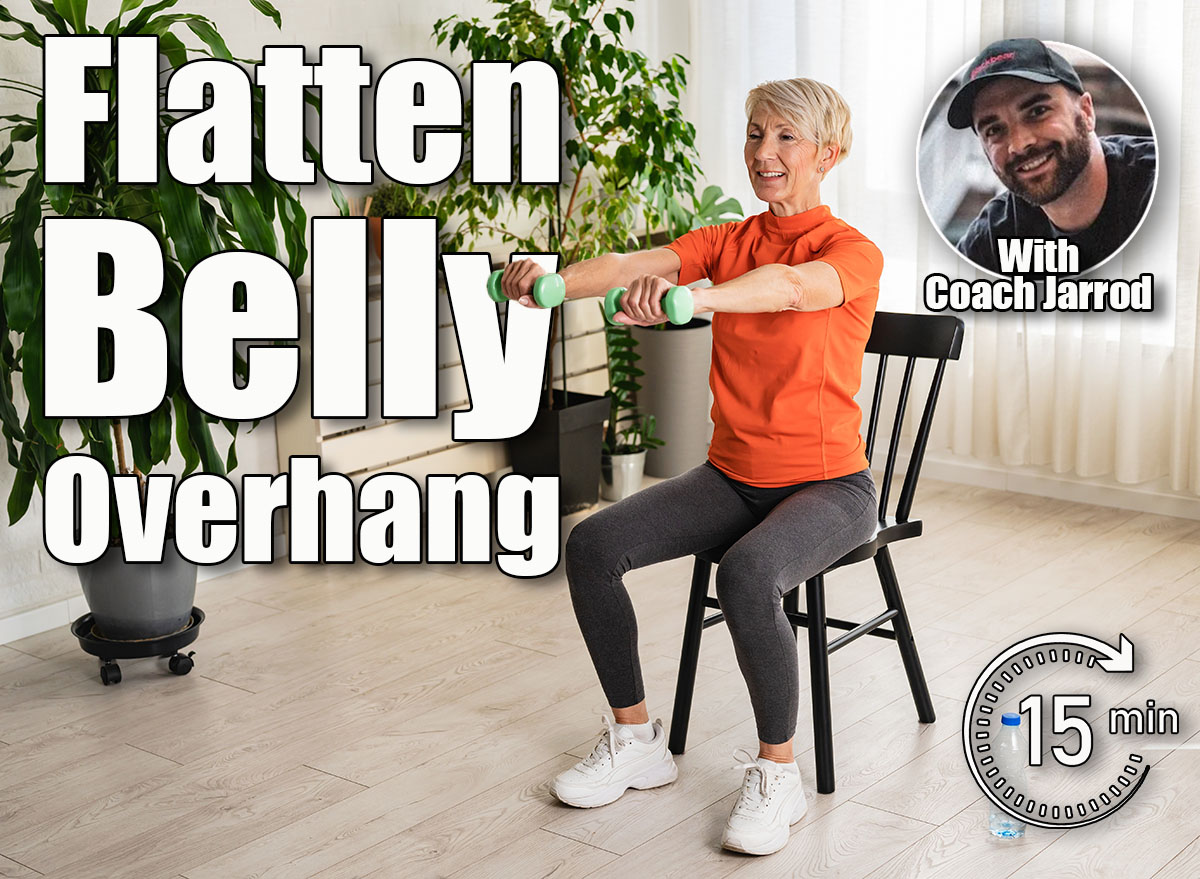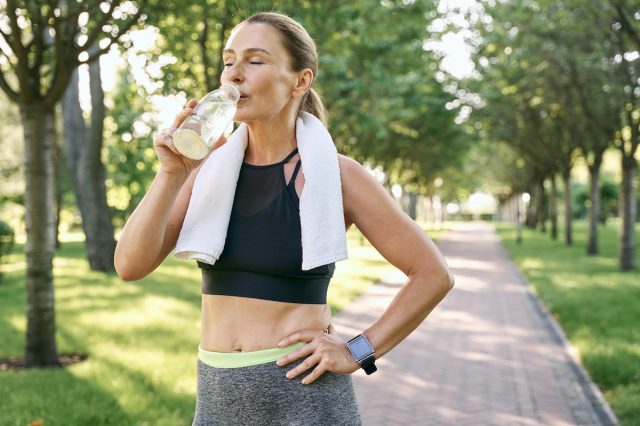5 Chair Exercises That Flatten Belly Overhang Faster Than Planks After 50

Belly overhang can feel stubborn, but targeting your core muscles with wise exercise choices helps reshape your midsection and improve overall strength. While you can’t spot-reduce fat, building lean muscle in your abs and surrounding areas increases your metabolism and makes your stomach appear flatter as you age.
For many, chair-based exercises are a practical and effective solution. Whether you’re working through joint discomfort, recovering from injury, or simply looking for an accessible way to train at home, these moves give you a potent way to engage your core without getting down on the floor. Done consistently, they build stability, improve balance, and contribute to better posture.
Chair workouts can also be surprisingly dynamic. Movements can target multiple planes of motion, forcing your muscles to stabilize and fire in ways traditional sit-ups or planks don’t always accomplish. The result is a more functional midsection that supports everyday movement, keeping you feeling strong and capable.
So grab a sturdy chair and get ready to turn your living room into a fitness studio. By the end of this workout, you’ll realize the only thing your chair is good for isn’t just sitting. In fact, you’ll never look at your seat the same way again because it’s about to become your best ab-day accessory.
5 Chair Exercises to Flatten Belly Overhang After 5
Seated Marching
Seated marching helps fire up your hip flexors, lower abs, and stabilizers in a way that mimics walking while adding a stronger core challenge. By lifting your legs while seated, you engage your lower abdominal wall, which directly contributes to tightening the area around your belly overhang. This low-impact move also boosts circulation and warms up your entire body.
Muscles Trained: Lower abdominals, hip flexors, quadriceps, core stabilizers
How to Do It:
- Sit upright in your chair with your back straight and feet flat on the floor.
- Brace your core by tightening your abs.
- Lift your right knee toward your chest, keeping your back straight.
- Lower your right foot to the floor.
- Repeat with your left knee, alternating sides in a marching rhythm.
Recommended Sets and Reps: Perform 3 sets of 20 to 30 marches. Rest 30 to 45 seconds between sets.
Best Variations:
- Hold light dumbbells in each hand to add upper-body stability work.
- Slow down the tempo for more time under tension.
- Add ankle weights for greater resistance.
Form Tip: Keep your torso upright and avoid leaning backward when lifting your knees.
Chair Core Rotations
Core rotations strengthen your obliques, which are crucial for trimming the sides of your midsection and reducing the look of belly overhang. Twisting from a seated position forces your abs to stabilize while challenging rotational strength, which translates directly to everyday movements like reaching, turning, and lifting.
Muscles Trained: Obliques, rectus abdominis, lower back muscles, hip stabilizers
How to Do It:
- Sit tall in your chair with your feet flat and knees bent.
- Hold your hands together at chest level.
- Brace your core and rotate your torso to the right as far as you can.
- Return to the center position.
- Rotate to the left and return to the center.
Recommended Sets and Reps: Perform 3 sets of 12 to 15 rotations per side. Rest 30 seconds between sets.
Best Variations:
- Hold a light dumbbell or medicine ball at chest level.
- Pause for 2 seconds at the end of each rotation for extra tension.
- Perform slow, controlled reps instead of fast ones.
Form Tip: Keep your hips and legs steady while rotating only through your torso.
Seated Chair Press-Outs
This move is a powerhouse for engaging your transverse abdominis, the deep core muscle responsible for pulling your stomach inward and flattening your midsection. The pressing motion mimics a plank-like engagement but in a seated, joint-friendly way. Over time, it builds endurance in the core muscles that support your spine and posture.
Muscles Trained: Transverse abdominis, rectus abdominis, shoulders, chest stabilizers
How to Do It:
- Sit upright with feet planted and core tight.
- Hold a light dumbbell, ball, or even clasped fists at your chest.
- Extend your arms straight out in front of you.
- Slowly bring your arms back toward your chest.
- Continue pressing out and pulling in with controlled tension.
Recommended Sets and Reps: Perform 3 sets of 12 to 15 reps. Rest 30 to 45 seconds between sets.
Best Variations:
- Use a resistance band looped around your back for extra resistance.
- Hold the press position for 5 seconds on each rep.
- Perform alternating single-arm presses.
Form Tip: Keep your core tight and avoid leaning forward as you press.
Seated Dumbbell Side Bends
Side bends target the obliques and directly work the muscles that help pull in your waistline. By adding resistance, this seated move becomes a serious ab and trunk strengthener. It’s particularly effective for addressing love handles and tightening the sides of the midsection.
Muscles Trained: Obliques, rectus abdominis, erector spinae, core stabilizers
How to Do It:
- Sit upright in your chair with feet flat.
- Hold a dumbbell in your right hand at your side.
- Slowly lean to the right, sliding the dumbbell toward the floor.
- Return to the starting position by engaging your left obliques.
- Complete all reps on one side, then switch to the other.
Recommended Sets and Reps: Perform 3 sets of 12 to 15 reps per side. Rest 30 seconds between sets.
Best Variations:
- Use a resistance band anchored under your foot.
- Hold the contraction for 2 seconds at the bottom.
- Perform alternating reps instead of one side at a time.
Form Tip: Avoid rounding forward. Stay tall and sturdy as you bend to target the obliques effectively.
Seated Chair Woodchops
Woodchops build rotational power and torch calories while targeting your obliques and lower abs. From a chair, they challenge your torso control while allowing you to move safely through a wide range of motion. This exercise simulates athletic twisting, making it functional for sports and daily life.
Muscles Trained: Obliques, rectus abdominis, shoulders, hips, and torso stabilizers
How to Do It:
- Sit tall with feet flat on the ground.
- Hold a dumbbell or medicine ball at one hip.
- Lift the weight diagonally across your body toward the opposite shoulder.
- Slowly return to the starting position.
- Repeat for all reps on one side, then switch to the other.
Recommended Sets and Reps: Perform 3 sets of 10 to 12 reps per side. Rest 45 seconds between sets.
Best Variations:
- Use a resistance band secured to the side of the chair.
- Perform faster, controlled reps for a cardio effect.
- Hold the top position for extra core tension.
Form Tip: Keep your movements controlled—avoid swinging the weight with momentum.
The Best Steps to Melting Belly Fat Past 50

Building a stronger core with chair exercises is only one part of the equation. Belly fat reduction requires a mix of consistent exercise, better nutrition, and lifestyle habits that support long-term results. The combination of these steps creates the environment your body needs to burn fat and maintain lean muscle.
Best Steps:
- Prioritize Protein: Aim for 20 to 30 grams per meal to support muscle growth and boost metabolism.
- Move Daily: Include both strength training and low-impact cardio, such as walking or cycling.
- Sleep Consistently: Get 7 to 9 hours of sleep per night to regulate hormones associated with fat storage.
- Stay Hydrated: Drinking enough water helps digestion and keeps you from mistaking thirst for hunger.
- Manage Stress: Elevated cortisol levels increase the likelihood of fat storage around your belly. Try meditation or deep breathing.
- Stay Consistent: Small, repeated actions over time deliver results that quick fixes cannot.
References
- Hewagalamulage, S D et al. “Stress, cortisol, and obesity: a role for cortisol responsiveness in identifying individuals prone to obesity.” Domestic animal endocrinology vol. 56 Suppl (2016): S112-20. doi:10.1016/j.domaniend.2016.03.004








